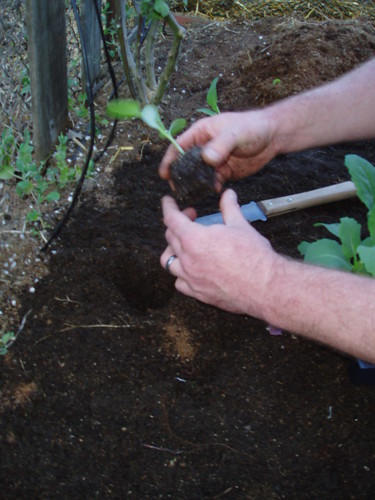Growing salad for two
If you've never had fresh, homegrown salad, now is the time to start. It doesn't take much space or sun, and your own salad will be so much better than anything you buy in a bag or a bunch that you won't believe you ever ate that sad, wilted stuff from the store.
You'll need about two square feet of garden bed per person. Prep the soil with lots of organic matter and mulch well with coconut pith.

To start, get two six-packs of lettuce per person and plant them at least six inches apart in staggered rows. Make sure you buy vibrant, young plants that are not root-bound, and of varieties that you like to eat. I do not recommend heading lettuce, though romaine will work fine. For each plug (if your nursery is like ours, there will be many seedlings in each plug, which is part of the plan), pull back the mulch, dig a small hole (really just pushing back the soil with your fingers), insert the plant, replace the soil and tamp, then replace the mulch.

When you're done, patch the mulch with more pitch and water in thoroughly.

You can also sow from seed. If you do so, sprinkle the seed onto the soil in foot-square patches of each type according to the planting instructions for the seed type. Don't be afraid of sowing too thickly because you will be thinning a lot of young plants. Sprinkle with more coconut pith, tamp down well and water in thoroughly.
The best way of watering is a twice daily sprinkling. Either automate this by installing misters on a drip system or using the mist setting on your hose. We find that five minutes twice a day is sufficient at 5 a.m. and 5 p.m. You want the water droplets to have a chance to evaporate before the sun hits otherwise you will get sun scald, which makes the lettuce inedible.
Once the transplants have recovered and started putting in new growth or your seedlings are about five inches tall, it's time to start harvest. Start by taking whole, young plants that are crowding others or otherwise badly placed (too close to the border, etc.). Snip them off at ground level. These greens will be very tender and require delicate handling. After a few harvests, you will be down to single plants spaced about six inches apart that are growing to about eight inches tall. Start harvesting the outer leaves for your salads, making sure to leave plenty of inner leaves for growth. At this point you will want to think about planting more seed or young plants in the spaces in between. As the big plants size up, begin to take whole plants for your salad, making sure to harvest them before they start to bolt (flower) or become bitter. By this point, the new plants that you sowed should be starting to size up and you can start the cycle again.
Harvesting lettuce
Try to take what you need without disturbing other plants or the root system. With some plants you can pull up on the stem after you've harvested the leaves and trim the stem below the mulch level, the pile pitch back over it for a tidy appearance.
Pile the salad into a basket or bowl, checking for slugs, earwigs and other unwanted guests (if you find them, toss them onto a flat surface like a sidewalk or road where the birds can get them). If it is very dirty, rinse with the garden hose (making sure the water is running cold) before bringing inside.
For very crispy salad (this works best with butter and romaine, but also works on other kinds), wash the salad well, then put in a plastic bag still very wet and let it sit in the refrigerator for a few hours or overnight. It will crisp up amazingly.
Site selection
Your lettuce bed should be as convenient as possible. If it's not possible to plant them directly outside your kitchen, get as close as possible. If you don't have bare ground or a raised bed outside your door, consider a planter box. If you have to travel to get to your salad, you won't harvest it enough. Put your salad bed where you will see it every day, and where you can access it easily. Be realistic.

Your salad should not get full sun in the summer. Pick a site that will be shaded either before or after noon (preferably after, depending on your climate). For a very hot climate, consider adding shading, such as shade cloth.
Bed cycling
For either method, about once a year harvest all of the salad and plow in the mulch, adding more organic matter like rabbit manure or another composted manure, worm castings and coffee grounds. If you have been having problems with predators, try a chicken tractor. If you are having disease problems, try rotating to another bed or planting a cover crop such as fava bans or an annual clover before growing lettuce again.
Pests
You will probably get some bugs, like pill bugs or slugs, nibbling on your salad. Our slugs seem to be very fond of the tatsoi in particular. There are many methods for deterring such little predators. I think the best method is to sow thickly and harvest a lot. That way it doesn't matter if the predators eat some, there's still plenty for you. Sluggo pellets also work very well for slugs and snails. Just strew the pellets on the ground around your plants.

